Males outnumber females in Davao de Oro by 4.6 percent
Based on the 2020 Census of Population and Housing (2020 CPH), Davao de Oro had a total population of 767,547 persons. Of this total, the household population comprised 99.8 percent or 766,299 persons.
Of the 766,299 household population in 2020, 400,687 (52.3%) were males while 365,612 (47.7%) were females. By age group, 246,249 (32.1%) were under 15 years of age (young dependents) wherein there were more males (51.8%) than females (48.2%) among them. (Figure 1)
On the other hand, persons 15 to 64 years (working-age or economically-active population) totaled to 481,890 (62.9%) and still, males (52.9%) outnumbered the females (47.1%) by 5.8 percent. While those in age groups 65 years and over (old dependents) comprised the remaining 38,160 (5.0%) wherein there were more females (52.5%) than males (47.5%). (Figure 1)
In 2015, the total household population of Davao de Oro aged 0 to 14 years, 15 to 64 years, and 65 years and over accounted for 33.7, 62.1, and 4.2 percent, respectively. (Figure 1)
Sex ratio stands at 110 males per 100 females
The sex ratio in Davao de Oro was computed at 110 in 2020. This means that there were 110 males for every 100 females. (Figure 2)
In addition, children aged below 15 years had a sex ratio of 108 males per 100 females, while those aged 15 to 64 years had a sex ratio of 112 males per 100 females. Moreover, among those aged 65 years and over, the sex ratio was 90 males per 100 females. This depicts a longer life expectancy among females than males or higher mortality rate among males than females in the older age groups. (Figure 2)
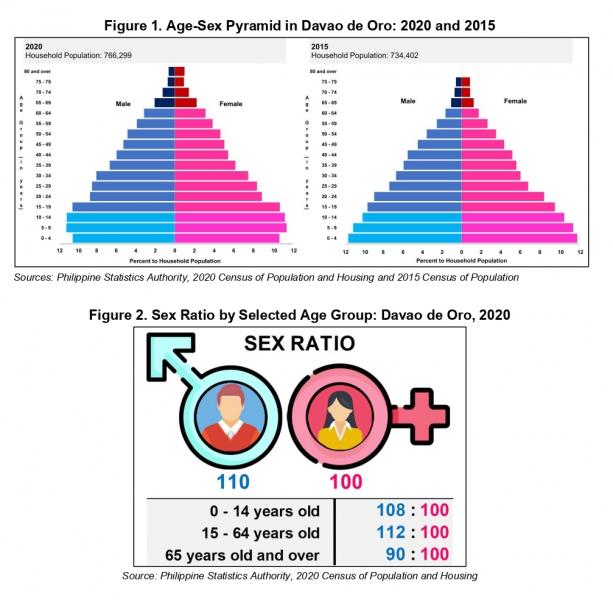
Median age increases to 24.4 years
The median age in Davao de Oro continues to rise during the past five years. In 2020, the median age was computed at 24.4 years, which means that half of the household population was younger than 24.4 years, while the other half is older than 24.4 years. This is higher than the median age of 23.3 years that was posted in 2015. (Figure 3)
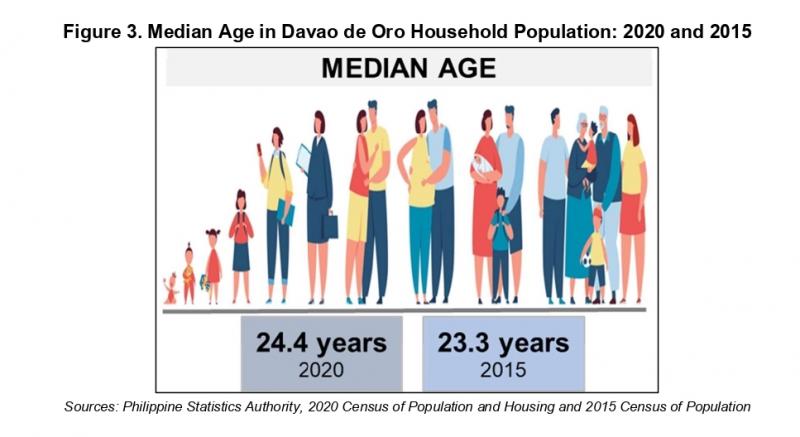
Dependency ratio declines to 59 dependents per 100 persons in the working-age group
The overall dependency ratio in Davao de Oro was computed at 59 which indicates that for every 100 working-age or economically-active population, there were about 59 dependents (51 young dependents and 8 old dependents). This is lower than the dependency ratio in 2015, which was recorded at 61 dependents per 100 working-age population (54 young dependents and 7 old dependents). (Table 1)

There are more males than females in children under five years old
Children below five years old has a contribution of 10.3 percent (78,742) out of the 766,299 total household population of Davao de Oro. This is lower than the 11.4 percent (83,554) posted in 2015. The sex ratio remained at 107 males per 100 females in 2015 and 2020. (Table 2)
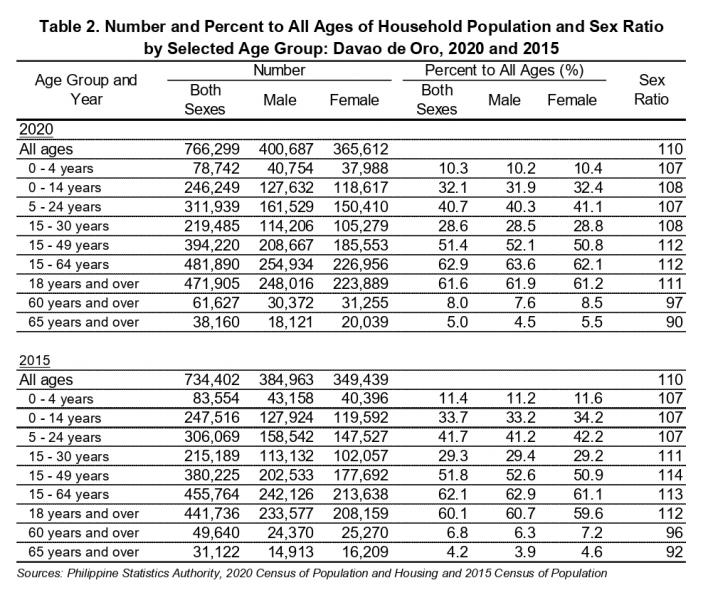
About two in every five household population are of school age
In 2020, the school-age population (5 to 24 years old) accounted for 311,939 (40.7%) of the 766,299 household population compared to the 306,069 (41.7%) school-age population that was reported in 2015. (Table 2 and Figure 4)
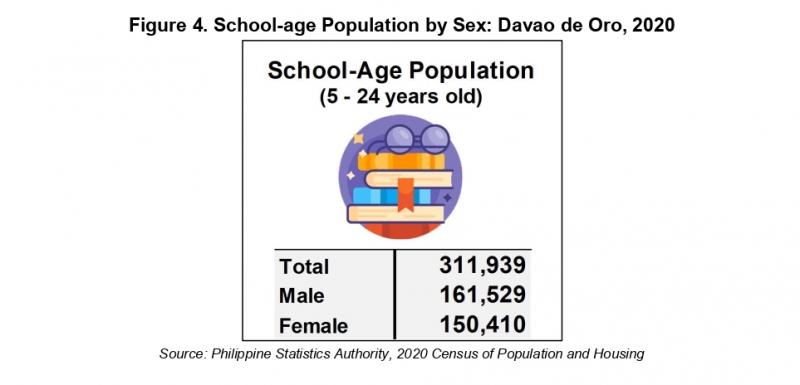
Youth accounts for less than a third of the household population
Youth or persons whose age ranges from 15 to 30 years totaled to 219,485 or about 28.6 percent of the household population in 2020, higher than the 215,189 (29.3%) recorded in 2015. (Table 2)
About 62 percent of the household population is of voting age
The voting-age population (18 years old and over) accounted for 61.6 percent (471,905) of the household population in 2020, up from 60.1 percent (441,736) in 2015. (Table 2 and Figure 5)
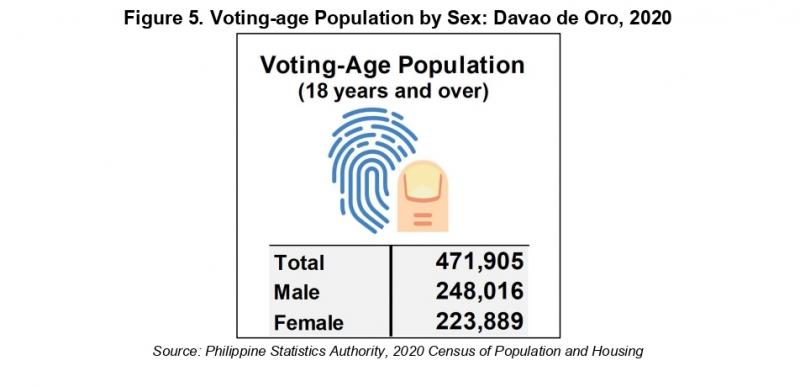
Senior citizens constitute 8.0 percent of the household population
In Davao de Oro, senior citizens (60 years old and over) made up 8.0 percent (61,627) of the household population in 2020, higher than the 6.8 percent (49,640) recorded in 2015. There were more females (50.7%) than males (49.3%) among the senior citizens, in 2020. The same trend was observed in 2015. (Table 2 and Figure 6)
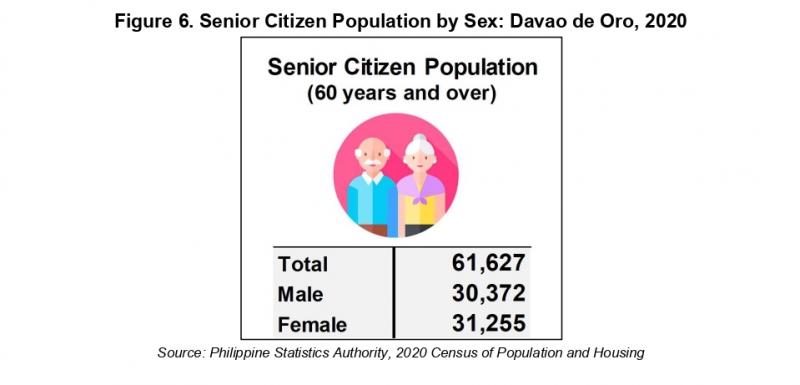
More than half of the female population are in reproductive age
The population of women under the reproductive age (15 to 49 years old) totaled to 185,553 or 50.8 percent out of the 365,612 female household population in 2020. These figures are slightly higher compared with the 50.9 percent (177,692) posted in 2015. (Table 2 and Figure 7)
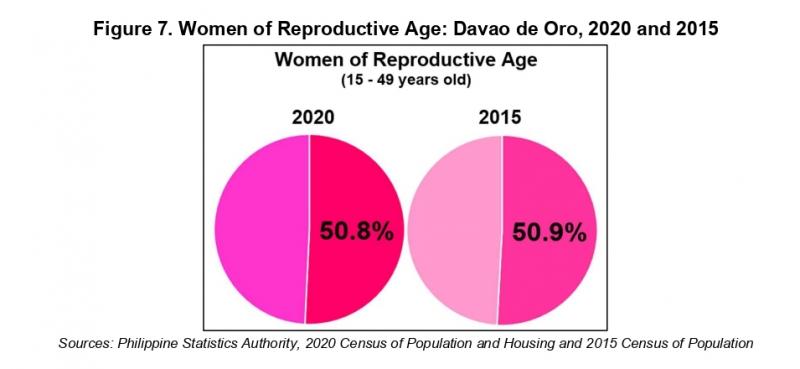
Aging index increases by 5.0 points from 20.1 in 2015 to 25.0 in 2020
In Davao de Oro, the aging index or the proportion of persons aged 60 years and over per 100 persons under the age of 15 years was computed at 25.0 percent in 2020. This means that there is one person aged 60 years and over for every four children under 15 years old. In 2015, the aging index was 5.0 percentage points lower at 20.1. (Table 2 and Figure 8)
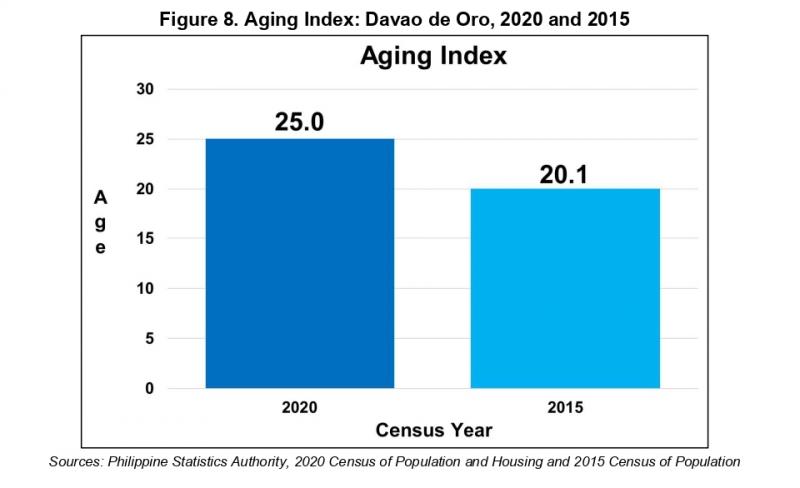
Technical Notes:
Household is a social unit consisting of person or a group of persons who sleep in the same housing unit and have a common arrangement in the preparation and consumption of food.
Household population refers to all persons who are members of the household.
Sex is the biological and physiological reality of being a male or female.
Age refers to the interval of time between the person’s date of birth and his/her last birthday prior to the census reference date. It is expressed in completed years or whole number.
Population pyramid is a bar chart, arranged vertically, that shows the distribution of a population by age and sex. By convention, the younger ages are at the bottom, with males on the left and females on the right.
Sex ratio is the number of males per one hundred females in a population.
Median age is the age that divides the population into two numerically equal groups; that is, half of the population are younger than this age and the other half are older.
Overall dependency ratio is the number of persons under 15 years old (young dependents) and persons aged 65 and older (old dependents) per one hundred persons 15 to 64 years old (working-age or economically-productive group) in a population.
Aging of population is a process in which the proportions of adults and elderly increase in a population, while the proportions of children and adolescents decrease. This process results in a rise in the median age of the population. Aging occurs when fertility rates decline while life expectancy remains constant or improves at the older ages.
Aging index is calculated as the number of persons 60 years old and over per one hundred persons under the age of 15 years.
